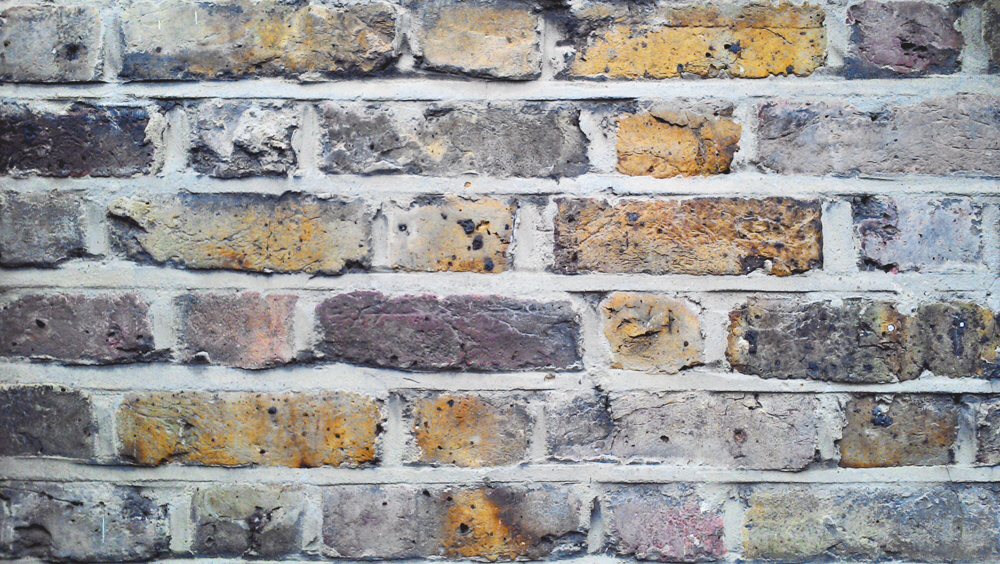Cement mortar
Mortar is applied as a thick paste which sets hard as it cures. It creates a tight seal between bricks and blocks to prevent air and moisture entering into a construction. It can compensate for variations in brick or block size to produce an aesthetically-pleasing and structurally-sound construction. Generally, mortar is intentionally structurally weaker than the blocks or bricks it bonds, creating a sacrificial layer that is more easily repaired than defects would be in the bricks or blocks themselves.
Mortar is composed from a mixture of a fine aggregate (typically sand), a binder and water. The binder is generally either lime or cement. If lime is used, mortar is described as ‘lime mortar’ whereas if cement is used it is referred to as ‘cement mortar’ (a small amount of lime may also be also be used in cement mortars). For more information see: Types of mortar.
Lime mortar tends to bind masonry more ‘gently’ than cement mortar, as it is more flexible and gives earlier adhesion, but it gains strength more slowly. Where less flexible, dense mortars such as cement mortar are used to bind softer masonry, such as soft sandstones, they can cause local stresses leading to the deterioration of the masonry. For more information see: Lime mortar.
Cement mortar was invented by English cement manufacturer Joseph Aspdin in 1794 in order to create a cement that was stronger than lime mortar.
Water and cement set and harden through a chemical reaction known as 'hydration'. The process of hardening is described as 'curing', which requires particular conditions of temperature and humidity.
There are a number of different types of cement. Portland cement is the principal cement used in most masonry mortars. It is manufactured by heating together limestone (or chalk) and clay (or shale) in large rotary kilns. The chemistry of Portland cement largely consists of calcium silicate which reacts with water to form a strong, durable cement paste. For more information see: Cement and Portland cement.
The ratio of cement to sand is typically in the ration of 1:2 to 1:6 depending on what the mortar is being used for, with a higher proportion of sand producing a weaker mortar. Where lime is included, the ratio is express as; cement: lime: sand.
Generally, the sand and cement are first mixed until uniform, and then water is slowly added while mixing until the required consistency is achieved.
Soft sand (building sand) is generally used for bricklaying and pointing using thinner layers of mortar, whereas Sharp sand is used where a thicker layer of mortar is required.
Premixed mortars are available to which water is added.
A range of different colours can be achieved depending on the type of sand used, or by the addition of dyes. A number of admixtures can also be included to accelerate or retard drying, to make the mortar easier to work, to improve waterproofing, to increase cohesion and so on.
[edit] Related articles on Designing Buildings Wiki.
Featured articles and news
ECA progress on Welsh Recharging Electrical Skills Charter
Working hard to make progress on the ‘asks’ of the Recharging Electrical Skills Charter at the Senedd in Wales.
A brief history from 1890s to 2020s.
CIOB and CORBON combine forces
To elevate professional standards in Nigeria’s construction industry.
Amendment to the GB Energy Bill welcomed by ECA
Move prevents nationally-owned energy company from investing in solar panels produced by modern slavery.
Gregor Harvie argues that AI is state-sanctioned theft of IP.
Heat pumps, vehicle chargers and heating appliances must be sold with smart functionality.
Experimental AI housing target help for councils
Experimental AI could help councils meet housing targets by digitising records.
New-style degrees set for reformed ARB accreditation
Following the ARB Tomorrow's Architects competency outcomes for Architects.
BSRIA Occupant Wellbeing survey BOW
Occupant satisfaction and wellbeing tool inc. physical environment, indoor facilities, functionality and accessibility.
Preserving, waterproofing and decorating buildings.
Many resources for visitors aswell as new features for members.
Using technology to empower communities
The Community data platform; capturing the DNA of a place and fostering participation, for better design.
Heat pump and wind turbine sound calculations for PDRs
MCS publish updated sound calculation standards for permitted development installations.
Homes England creates largest housing-led site in the North
Successful, 34 hectare land acquisition with the residential allocation now completed.
Scottish apprenticeship training proposals
General support although better accountability and transparency is sought.
The history of building regulations
A story of belated action in response to crisis.
Moisture, fire safety and emerging trends in living walls
How wet is your wall?
Current policy explained and newly published consultation by the UK and Welsh Governments.
British architecture 1919–39. Book review.
Conservation of listed prefabs in Moseley.
Energy industry calls for urgent reform.




























